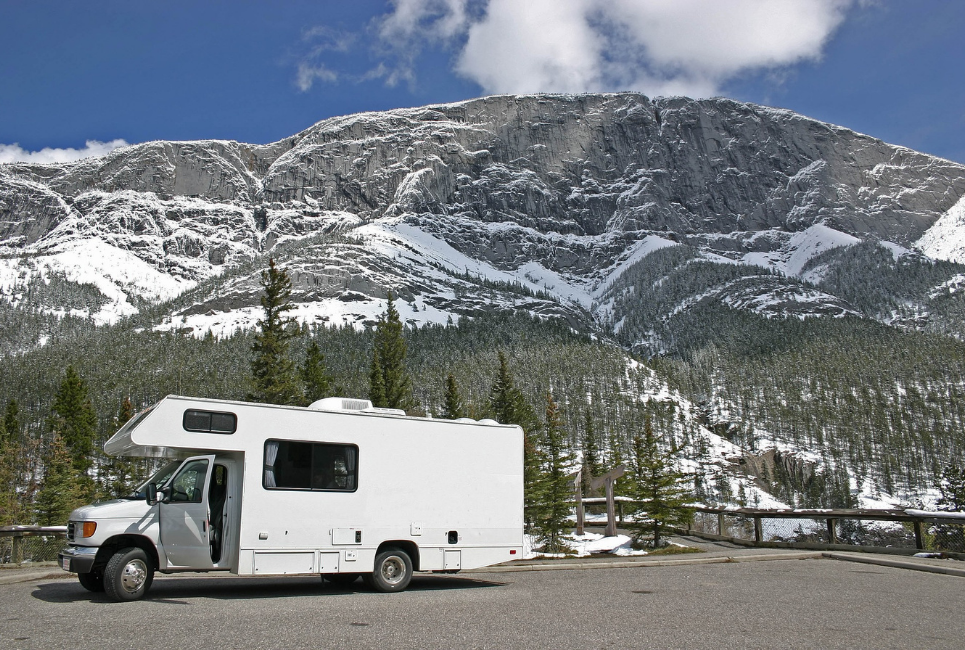When the weather starts to turn cooler, many RVers winterize their rigs so they can store them until warmer temperatures return. Others like to stretch the RVing season as far as they can, even RVing in winter conditions. Whether you are looking at chilly weather in the shoulder seasons or considering winter with below-freezing conditions, staying warm and cozy is a high priority.
There are many reasons to use your Recreational Vehicle’s built-in propane furnace when the mercury starts to dip. This system is designed to circulate heat evenly throughout your rig, as well as warming your underbelly to prevent tanks and water lines from freezing. It may even warm some of your basement storage to protect the items you have stored there from extreme temperatures.
There are also reasons why you may not want to heat your RV using propane. Having alternatives allows you to adapt to different circumstances. If you want to reduce your reliance on propane heat or possibly aim to avoid it altogether, there are a number of options to consider. Before we get into our full guide on how to heat an RV without propane, let’s look at some of the disadvantages of using one.
Disadvantages of Propane
Given the advantages of using the built-in propane furnace that came with your rig, why would anyone consider heating their RV without propane? For all its advantages, propane heat has some disadvantages as well.
Moisture
Moisture is the enemy of your RV at any time of year, but this battle intensifies in colder temperatures. Most RVs are not well insulated, and when it is cold outside and warmer inside, condensation can become a huge issue. It’s one thing when it’s dripping down your windows, but quite another when condensation is on your walls, inside your cabinets and seeping into the furniture.
Everything becomes damp and the mold risk is high. This is true regardless of how you heat your RV, but propane heat makes the situation worse. One of the byproducts of burning propane is water, so your propane furnace works against you in the battle against moisture.
Cost
If you are relying on propane heat during cold weather, you will need to refill your tanks often. The cost of buying propane frequently can really add up! If you are staying in a campground that includes electricity with no additional charge, using electric heating options can reduce or even eliminate these propane costs.

Convenience
If you have a drivable RV, such as a Class A or Class C motorhome, your propane tanks are most likely built into your RV. This means that refilling them requires driving your RV to the propane filling station. If you need to refill often, it can be very inconvenient to disconnect and move your rig.
If your RV is towable, such as a travel trailer or fifth wheel, then this is less of a factor because your propane tanks are probably external. Either way, no one wants to spend too much time refilling propane. Reducing your propane consumption is much more convenient.
Factors to Consider
There are many options available when it comes to electric heat in your RV. Which one you should choose depends on a variety of factors. When considering your needs, it is important to ask yourself these questions:
- How cold will it be? Are you simply wanting to extend your camping season into the shoulder seasons (spring and fall) or will you be using your RV in the winter conditions? Is it likely that the outdoor temperature will drop below freezing? If so, for how long?
- Do you need underbelly heat? Is your underbelly enclosed? If so, this will offer some protection for the occasional short dip into freezing temperatures. If you anticipate prolonged exposure to freezing temps, then you need to keep your underbelly above freezing. You do NOT want your tanks and water lines to freeze.
- Do you have shore power available? Will you always be in a campground with electric hookups (shore power)? If not, you will still need to rely on propane. A small investment to help reduce propane use when you do have shore power may still be worth it, but you may not want to make a huge investment in an electric solution you’ll rarely use.
- Do you have a 30-amp or a 50-amp rig? Watch out for how much power you’re using for electric heat. For a 30-amp rig, you will need to be especially careful to choose heat solutions that do not exceed your capacity. You may also need to turn the heater off temporarily to use other appliances such as your microwave. In a 50-amp rig, you have much more wiggle room, but you still can’t consume power in the same way you would in a house.
- How handy are you? Some electric heating options are as simple as plugging in a space heater, while others require a bit of installation. If you are handy when it comes to DIY projects, this may not be a major factor for you. If not, you may need to add the cost of professional installation to your budget. It may not be worth it for you.
- What is your budget? A wide range of options comes with a wide range of price points. The savings on propane over time may or may not offset the cost of your electric solution, so consider how much you are willing and able to spend as you consider the benefits of each option.
Non-Propane Heating Options for Your RV
Space Heaters
There are a variety of different types of space heaters available. Some types are well suited to RV life while others may not be. Ceramic space heaters, with or without a fan, and fan space heaters are very widely available and most can easily be used in your RV.
Oil-filled space heaters, also known as radiator-style heaters, are often too large and heavy to be practical for RV use.
Infrared space heaters may also be an option. Although they tend to be heavier than an average space heater, they are cool to the touch when in use, which can be a safety advantage.
Be careful using space heaters on laminate RV floors, as direct exposure to heat on a regular basis can speed the process of delamination, giving your floors a spongy feel in the places you’ve used the heater. I speak from experience here.
This can be avoided by elevating the heater on a table or counter top or by choosing a tower-style heater that blows the heated air higher and away from the floor.
*Note: Never use space heaters while your RV is in motion. These suggestions are only for times when your RV is stationary.
Advantages of Space Heaters
- Space heaters require no special skills for installation, they are generally inexpensive, and they are easy to find in stores.
- They can heat up a chilly RV quickly and usually have settings that can be adjusted to use less power when needed.
- You can often find models that are small and light, which is ideal for RV life, especially if they are not used frequently.
Disadvantages of Space Heaters
- It can be difficult to get the heat from a space heater to circulate well throughout the RV, particularly in bedrooms and bathrooms.
- Space heaters only warm the interior of the RV and do not provide heat to the RV underbelly.
- Space heaters should be placed in open spaces, avoiding close contact with furniture, which can be difficult in some RV layouts.
- They must be used carefully to avoid floor delamination, as described above.
Recommended Models
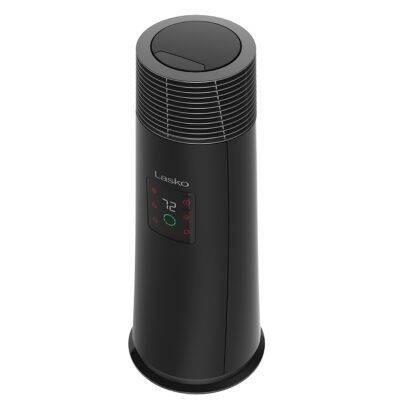
After having tried several different types of space heaters in our RV, this is the one we are currently using and we’re very happy with it. We especially like that it can be set to rotate 90 degrees, 180 degrees, or 360 degrees, which helps a lot with circulation.
The different level settings have worked well in our 30-amp rig. The tower format has helped protect our floors from further damage after some delamination was caused by smaller and lower to the ground models.
The remote control is also a nice feature. This heater is 24 inches tall and weighs a little over 7 pounds.
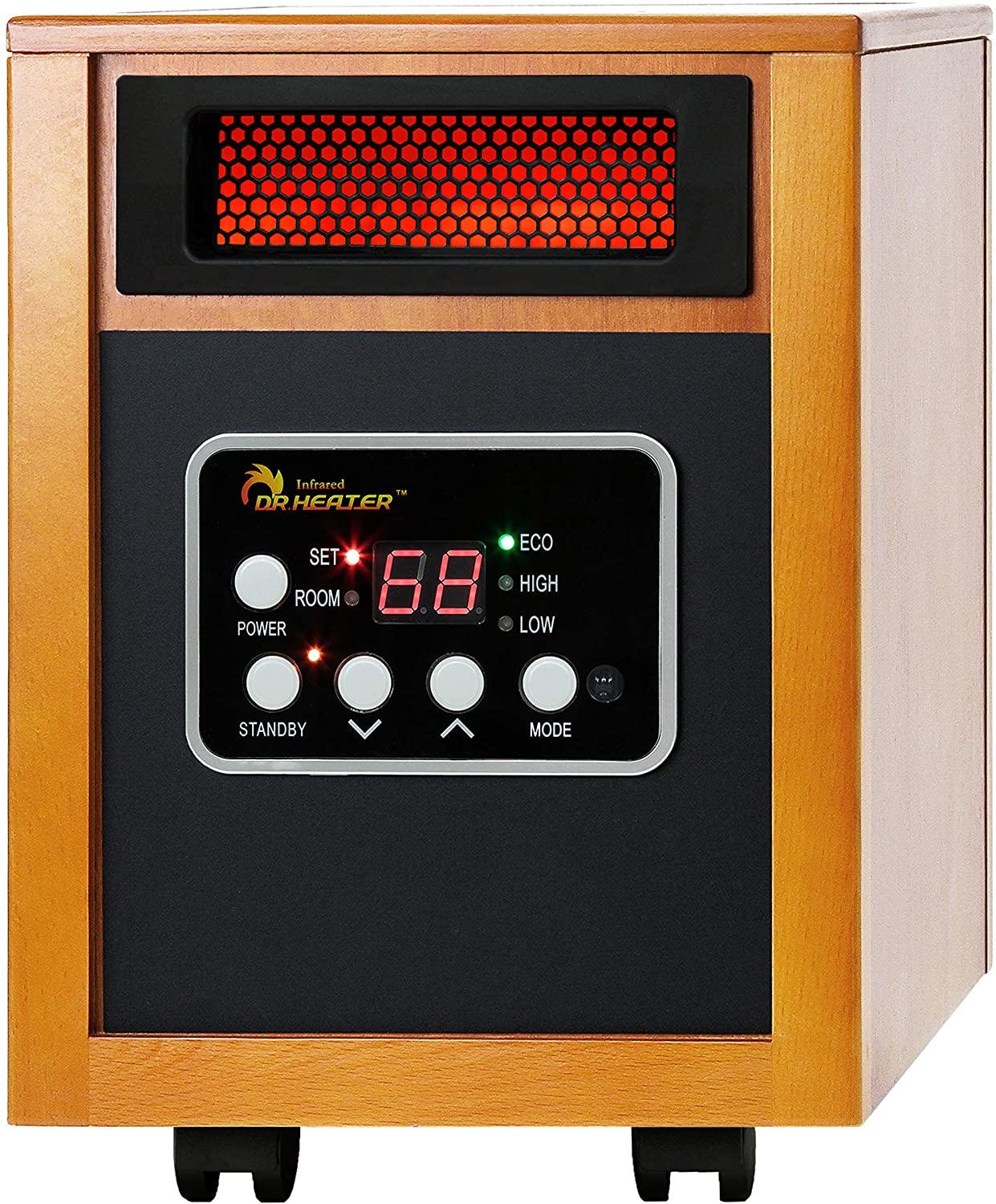
If you’re looking for an infrared space heater, many RVers have been very happy with this model. While there may be some advantages to infrared heat, for us the increased weight is a deal-breaker.
This model weighs in at 24 pounds, more than three times as much as the model we prefer. With limited weight margins for cargo, we’d rather fill those 17 pounds with books or something else that’s more fun.
Heated Blankets
While heated blankets will not heat your whole RV, in many situations they may provide you with all the heat you need. If your cold weather plans are focused mainly on the shoulder seasons, when it gets cool at night but is still comfortably warm during the day, it may be enough to sleep with a heated blanket to stay warm without needing to heat your whole rig. For many people, it’s an option worth considering!
One advantage of heated blankets is that they can run on your RV’s 12-volt battery system instead of the 120-volt electrical system. This means that you can use them even if you don’t have access to shore power.
Advantages
- If all you need is to stay warm while sleeping, heated blankets are more efficient and use less energy. Being able to use them with or without shore power is another big advantage.
- They can help you conserve propane during cold weather by allowing you to keep the ambient temperature cooler without being uncomfortable while sleeping.
- No installation is required and they are readily available in many stores.
- They are small, light, and convenient.
Disadvantages
- Heated blankets will keep you cozy and warm in your bed, but getting up at night to use the bathroom will definitely remind you that you’re camping.
- They will obviously not help protect your tanks and lines from freezing, and should not be considered a complete solution for winter temperatures.
Recommended Models
This blanket comes in twin, full, queen, and king sizes. The queen and king sizes have dual controllers, which I love because my husband and I have very different ideal sleeping temperatures. The 10 different temperature settings allow you to be comfortable and control how much power you’re using.
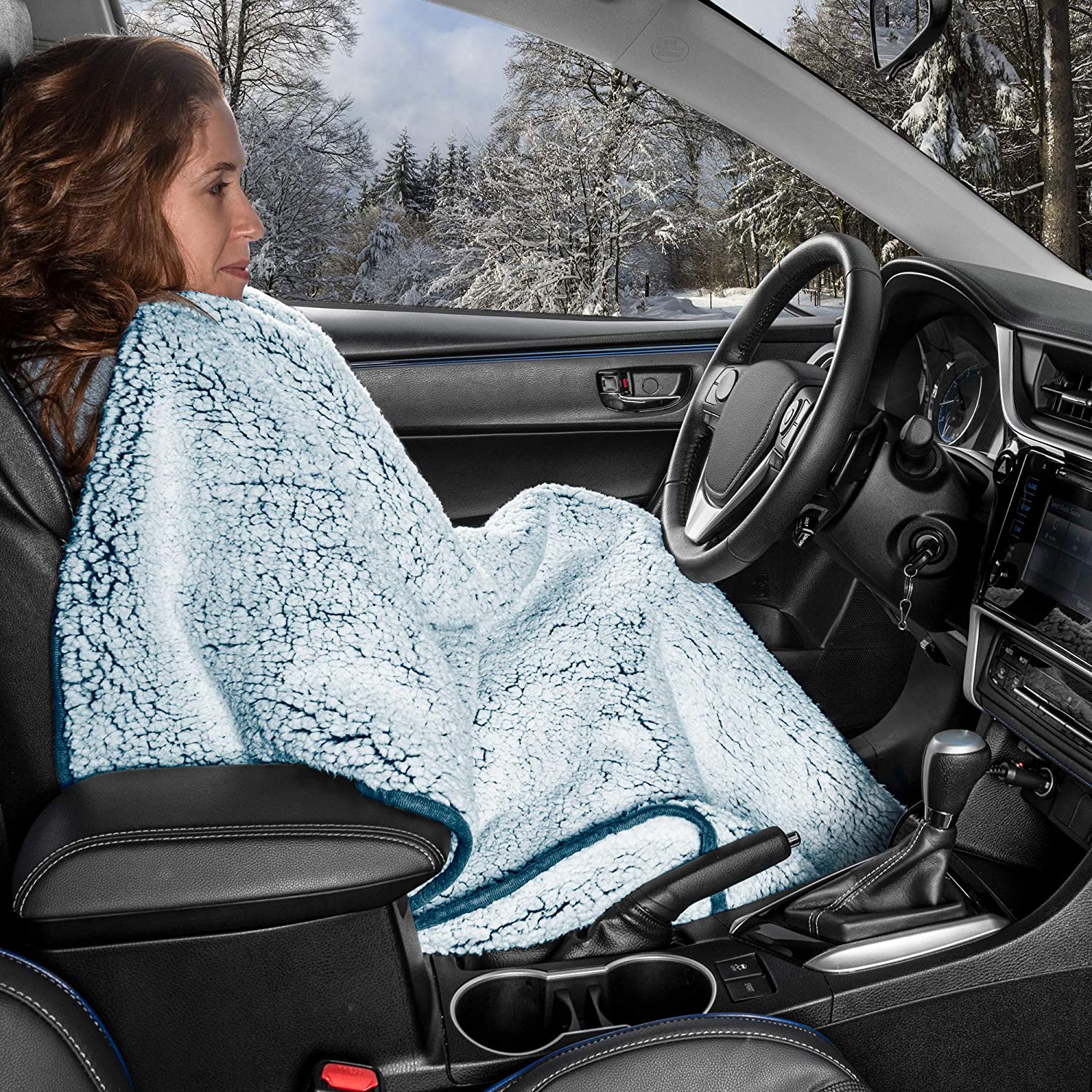
The 10-hour automatic shut-off time helps if you forget to turn it off, but it isn’t so short that you’ll wake up cold in the middle of the night. Double check that the length of the cord reaches well to the locations of your outlets.
Since most 12V heated blankets are designed for use in the car, it is difficult to find a queen-sized 12V blanket. Most are throw blankets. This one is full sized, so you may need two to cover a queen- or king-sized bed.
The cable length is generous, which helps because your 12-volt outlets may not be right next to your bed. Be aware that this model does not have automatic timers and it cannot be machine washed.
Dehumidifiers
A good dehumidifier makes a huge difference in the battle against moisture and condensation while camping in cold weather. Regardless of what kind of heating solutions you choose, keeping the indoor humidity low is essential to comfortable RVing in cooler temperatures. Since you will need a dehumidifier anyway, why not choose a model that actually contributes to heating your rig at the same time?
Advantages
- Using a dehumidifier for heat saves space as it can avoid the need for double appliances (dehumidifier and space heater).
- It can also reduce power usage for the same reason.
- Anything that can fill multiple functions is great for RV life.
Disadvantages
- Not all dehumidifiers give off any noticeable heat, so be careful which model you choose.
- Many dehumidifiers are too bulky and/or heavy to be practical for RV use.
- If you also plan to use your dehumidifier in the summer, you might not appreciate the heat output, which can’t be turned off.
- Dehumidifiers generally cost more than simple space heaters.
Recommended Model
We have used this particular model in our RV through a full winter season and it was a complete game changer. We rarely experienced any condensation and it reduced our need to run another space heater or our propane heater in all but the coldest conditions.
This model is compact and lightweight compared with other dehumidifiers on the market. On the low setting, it only draws 280 watts, so it can run alongside other appliances without tripping a breaker. We couldn’t be more satisfied with it.
A/C Conversions
Many newer RV air conditioner models are actually heat exchange units which can also be used as electric heaters when you need the air warmed instead of cooled. If you have an older model that doesn’t have this feature, you can purchase a conversion kit to achieve the same functionality. Most RV air conditioners have space to install an aftermarket part that will make your A/C unit able to pull double duty.
Advantages
- This solution uses the air ducting that already exists for your air conditioner, so the heat circulates well throughout your rig.
- Once installed, this part does not take any additional space, saving your limited floor space.
- You’ll never worry about tripping over a space heater cord.
- The cost of purchasing the part is similar to the cost of purchasing a space heater.
Disadvantages
- The conversion part requires installation. While it is not a complex installation, it certainly requires more skills than plugging in a space heater or dehumidifier.
- If you are not comfortable doing the installation yourself, hiring a professional will increase the cost of this solution.
- Unlike stand-alone appliances, the A/C conversion can only be used in your RV and not for other purposes.
- This is not designed to be a primary heat source and if it runs constantly it may burn out, so it must be combined with other heaters in winter conditions.
Recommended Models
Because the conversion kits are made to be installed in your existing air conditioner, choose your kit based on which type of air conditioner you have. Check your owner’s manual to make sure you choose the right kit for your A/C unit. Here are kits for two of the most common A/C manufacturers:
Electric Add-on for Propane Furnace
In cold weather, your RV is designed to work best with heat from your propane furnace. Since warm air rises, the heating vents are in the floor, in contrast with A/C ducts which are usually in the ceiling. The heat from the furnace circulates through the underbelly and any heated basement storage compartments. The ultimate propane-free heating solution for your RV, then, is an electric add-on to your propane furnace, giving you all the advantages of propane heat but using shore power instead.
Advantages
- Because this solution uses the existing heat ducts for your rig, this is the only electric heat solution that will also protect your underbelly and basement storage areas just like your propane furnace.
- You can easily switch from electric to propane and back again with the flip of a switch.
- There are three different settings to regulate power consumption, though 30-amp RVs will only be able to use the lowest setting.
- It doesn’t require any additional space and it connects to your normal thermostat system.
Disadvantages
- Installation of the electric add-on is somewhat complicated and requires the ability to work safely with electric wiring.
- Because it is a less common solution, it may be difficult to find a professional who is familiar with the installation.
- Professional installation can take 5-8 hours so professional installation raises the cost of an already pricey solution.
- In contrast to stand-alone appliances, this add-on can only be used in your RV.
Recommended Model
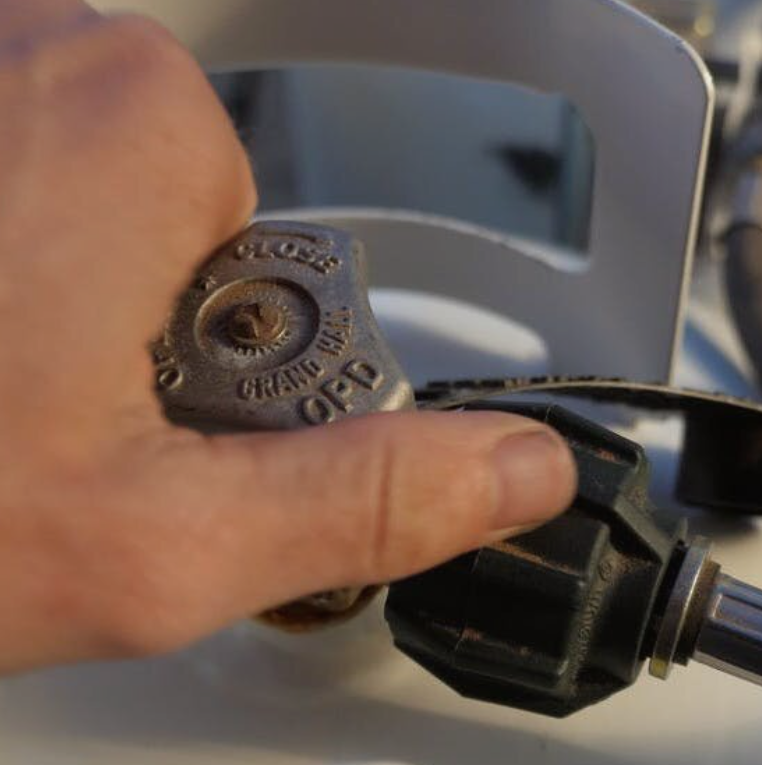
I have not tried this system personally, as the price tag is a bit prohibitive based on our current needs. If we often spent winters in colder climates, however, we would certainly consider it. It would pay for itself in saved propane costs in approximately 2-3 seasons and the convenience would make it worth the investment.
Choosing the Best Option for Your RV
| Type of Heat | Outdoor Temperature Range (℉) | Ease of Installation | Wattage Required | Underbelly Heat | Price Range |
| Space Heaters | 32+° or combine with propane furnace | Easy | 1500 watts | No | $50-$150 |
| Heated Blanket | 40+° or combine with other heat | Easy | Varies
45+ watts |
No | $50-$200 |
| Dehumidifier | 33+° or combine with other heat | Easy | 280+ watts | No | $175-$200 |
| A/C Conversion Kit | 40+° or combine with other heat | Moderate | 1500 watts | No | $70-$100 |
| Electric Furnace Add-on | No restrictions | Difficult/ Professional | 1800+ watts | Yes | $800 – $1,500 (installed) |
Top Choices
Chilly Shoulder Seasons
As long as the temperature stays above freezing, a space heater is a simple and easy solution for heating your RV without propane. Space heaters are inexpensive and they can be used elsewhere when you’re not using your RV. Generally, ceramic heaters with fans are a great lightweight solution to circulate heat with a small footprint.
Since spring and fall can be damp and rainy, supplementing your heating needs with the Ivation dehumidifier will also help you manage moisture and avoid mold issues. If all you need is to take the chill out of the air on cool nights in the shoulder seasons, the dehumidifier may be sufficient in itself to meet your needs.

Winter RVing
If your budget allows, it is hard to top the Electric Furnace Add-on from CheapHeat. Because it is the only solution that helps warm your underbelly, it is the only electric RV heating solution that can fully replace propane heat in winter conditions.
Whether or not you choose to make your propane furnace a hybrid system, I highly recommend the Ivation dehumidifier. In winter conditions, it is essential to manage your humidity levels well to reduce condensation, and it seems like a no-brainer to choose a dehumidifier that will also help heat the space and reduce your need for other heaters.
In Conclusion…
If you enjoy RVing, there’s no reason that your season has to be confined to summer weather! There are many options to keep your rig warm and comfortable without using propane. Choose the one that’s right for you and enjoy your extended camping season!
Frequently Asked Questions
Question: Does RV Heat Work Without Propane?
Answer: The built-in furnace in your RV does not work without propane. The 12-volt electric system (running from your battery) drives the fan to circulate the heat through the vents throughout your RV, but the heat being circulated is generated by burning propane. The system needs both to heat your rig. The exception to this is if you have installed an aftermarket conversion that allows your furnace to generate heat using electricity.
Question: Do RV Furnaces Run on 12-Volt?
Answer: Yes, most RV furnaces use your 12-volt power system to run the fans that circulate heat. This means you can run the heat without being connected to shore power for as long as your battery capacity allows. The furnace also requires propane in order to produce heat.
Question: How can I Heat my RV Cheaply?
Answer: The cheapest way to heat your RV depends on your circumstances. If you are in a campground that includes electricity in the cost of your site, then using electric-based heat will save you money. If you are paying for your electricity use, then using the propane furnace will most likely be your cheapest form of heat.

